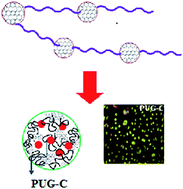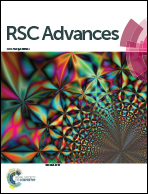Graphene as a chain extender of polyurethanes for biomedical applications†
Abstract
Amine-functionalized graphene has been chemically tagged within long-chain polyurethane molecules, using graphene as a chain extender to prepare a nanohybrid, and its novelty has been explored by comparing its properties with those of physically dispersed functionalized graphene in polyurethane based on di-ol as a chain extender. Chemical tagging has been confirmed through NMR studies and the nature of the interaction between the polymer matrix and graphene (nanofiller) is stronger in the chemically tagged nanohybrid compared to a nanohybrid prepared through physical mixture, as revealed from FTIR, UV-visible and PL spectroscopic measurement. A homogeneous dispersion of graphene platelets is achieved through a chemically tagged nanohybrid as against the agglomerated nanostructure found in a physically mixed nanohybrid. Enhancement of thermal properties and toughening of the nanohybrids is observed, whose extent is significantly higher in the chemically tagged nanohybrid due to greater interactions between the components and the uniform dispersion of nanofiller. Graphene-induced self-assembly from the nanometer scale to the micron level (step by step) was investigated through X-ray diffraction, small angle neutron scattering, atomic force microscopy and optical images in the order of nanometer, tens of nanometer, hundreds of nanometer and micron size, respectively. The effects of self-assembly on drug release and the biocompatible nature of the nanohybrids were monitored using HeLa cells, looking at cell viability, cell adhesion and fluorescence imaging. Significant sustained release of an anti-cancer drug was obtained using the chemically tagged nanohybrid and understanding gained of its kinetic behavior and mechanism. The greater biocompatibility of the chemically tagged nanohybrid was revealed through cell adhesion and fluorescence imaging, demonstrating a superior biomaterial which delivers the anti-cancer drug in a sustained manner. Hence, the developed nanohybrid is a potential biomaterial for drug delivery and tissue engineering.


 Please wait while we load your content...
Please wait while we load your content...